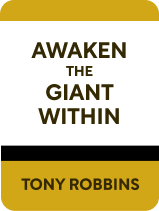

This article is an excerpt from the Shortform book guide to "Awaken the Giant Within" by Tony Robbins. Shortform has the world's best summaries and analyses of books you should be reading.
Like this article? Sign up for a free trial here .
How can you change your story, Tony Robbins style? What great things happen when you change your story?
Change your thoughts, change your life. The story you tell yourself dramatically changes the way you see the world, from your opinion of yourself, to how you respond to problems. Knowing how to change your story will improve your self-confidence, personal relationships, career, and much more.
Keep reading to find out how to change your story, Tony Robbins style.
Tony Robbins: Change Your Story to Change Your Life
If you want to change your story, Tony Robbins says you must first understand how your decisions, values, and beliefs affect you. Change your story the Tony Robbins way with the following advice.
The first step to change your story, Tony Robbins says, is to understand the power of your decisions. Many people mistakenly believe their lives are shaped by their circumstances—they go where the current takes them without making any active decisions, feeling out of control. However, life is actually dictated by decisions. When you make a decision about who you are and what you want, you’re making a commitment to do anything necessary to realize that vision. Each decision—no matter how small—sets into motion a series of actions and events that ultimately shape your life.
To embrace your decision-making power, first, remember that decision-making is like a muscle that you strengthen by making frequent decisions—so keep making them. Second, make your decisions wisely, but don’t mull over them endlessly; if you think about them for too long, you’re likely to lose your conviction. Third, learn from your successful and failed decisions. Finally, be conscious about how you make these three decisions, which impact what you notice, how you feel, what you do, and who you become:
- Decide what to focus on.
- Decide what certain things mean to you.
- Decide what you’re doing to produce the results you want.
1) Understand Neuro-Associations
The driving force behind all of your decisions—and, thus, your actions—is the subconscious motivation to avoid pain (such as inconvenience and humiliation) and seek pleasure (such as ecstasy and comfort).
Pain and pleasure associations start in your brain: Every time you experience a positive or negative emotion, your brain links the emotion with other aspects of the experience, creating a “neuro-association.” As a result, your future thoughts about that activity or subject automatically trigger the same emotion. (Shortform example: If you once got emotionally painful news while listening to a certain song, your brain will associate that song with your negative emotion; so, each time you hear the song in the future, you’ll feel emotional pain.)
When your brain creates neuro-associations, it looks for patterns to form generalizations about which experiences are painful or pleasant. These generalizations create your beliefs about life and the world, and they can be critical to learning, for example, that touching a hot stove hurts. However, some of your generalized beliefs hold you back from achieving what you want—for example, if an ex cheated on you, it could cause you to believe that all intimacy leads to pain, meaning you avoid close relationships.
Create Change by Rewiring Your Brain
If some of your neuro-associations are causing you to act in ways that are not positive or empowering, change them: Rewire your brain by weakening your existing neuro-associations and consciously creating new, empowering ones.
Your brain has billions of neurons that communicate by sending signals to each other via neural pathways, which is the method by which your brain creates neuro-associations. The more you repeat the same or similar experiences, the stronger those connections become—and the stronger they become, the more automatic and habitual that behavior becomes. If you’ve developed strong neural pathways reinforcing a negative emotion or behavior, it’s difficult to fight against the force of that habit and implement a more positive behavior.
To change those neural pathways, associate intense pain with the old, negative behavior and pleasure with the new behavior. You can do this using the Science of Neuro-Associative Conditioning (NAC), a six-step process through which you condition your nervous system to develop neuro-associations that support the changes you want to make:
- Determine exactly what you want and identify the pain you’ve associated with making this change. For example, you may want to lose weight but associate the process with the pain of hunger and the physical pain of exercise.
- Create a sense of urgency to change. What consequences will you face for not changing, and what benefits will you gain if you do change?
- Disrupt your pattern. Every time you catch yourself slipping into your old pattern, do something unexpected to snap out of it. Over time, these disruptions will distort and weaken the neural pathways responsible for your old behavior.
- Create a positive pattern to replace the old, negative one. If you don’t, the change won’t last and you’ll revert to your old pattern or a new, negative one.
- Reinforce your new pattern so that it endures long-term. Rehearse your new response in your mind to strengthen the new neural pathways and create a reward system to reinforce your new pattern.
- Make sure your conditioning is successful. Imagine a scenario that would trigger your old response and see if you still react in the way you used to.
2) Alter Your Beliefs to Change What’s Possible
Now that you know how to recondition your neuro-associations, you can identify which associations and beliefs are impeding your success and recondition yourself to turn your disempowering beliefs and associations into empowering ones. Your beliefs dictate how you interpret your experiences, and these interpretations determine your decisions, which collectively shape your life.
At its heart, a belief is a feeling of certainty about an idea, and your certainty is based on the experiences that you’ve interpreted as evidence—or references—to support the idea. Since, through imagination, you can find or create references to support any belief, you can turn any idea into a belief. Furthermore, you have the power to adopt beliefs that empower you.
Global beliefs are the most influential beliefs, because they determine how you think about life or yourself as a whole. For example, you may have a global belief that life is a struggle. Altering your global beliefs through reconditioning can transform your life. Think of the impact of shifting from the belief that life is full of challenges to a belief that life is full of opportunities.
Another type of belief, a limiting belief, forms when your brain oversimplifies your experiences. For example, if you’ve failed at your first few attempts to launch a business, you may develop a limiting belief that you’re not cut out for entrepreneurship, overlooking the fact that most entrepreneurs endure and overcome failure.
Limiting beliefs can become self-fulfilling prophecies, as they inform your decisions, which dictate your actions, which shape your future. For instance, if you have the limiting belief that you’re not suited for entrepreneurship, then you won’t continue trying to start your own business, and you will never become an entrepreneur, essentially confirming your limiting belief.
To break your limiting beliefs, rely more heavily on references of imagination rather than experience. For example, as an aspiring entrepreneur, instead of focusing on your past experiences of failure, vividly envision yourself launching and growing a successful business. This will help you believe that you can do it.
3) Control Your Focus
In addition to your beliefs and associations, what you choose to focus on determines how you experience life and what emotions you feel. Think of your focus as a camera lens and reality as a party: Your camera can only capture one small piece of the whole scene. If the camera focuses on a couple arguing at the party, it gives the impression that the party is full of conflict, but if you focus on a group of friends dancing and laughing, it makes it seem like the party is fun and lively.
In this section, we’ll talk about how to control your focus through the questions you ask yourself and the words you use.
Use Empowering Questions to Direct Your Thoughts
Thinking is merely a sequence of asking and answering questions—in other words, virtually every thought you have is preceded by a question, even if it’s not one you consciously asked. The questions you ask yourself set the tone for your thought patterns, so it’s critical to make a habit of consciously asking yourself positive, empowering questions that will lead to empowering thoughts.
For example, if you’ve tried and failed to skateboard three times in a row, ask yourself, “What do I need to do differently?” This is an empowering question that’s framed to find a solution, and it leads to empowering, concrete solutions, such as, “Adjust my footing.” Don’t ask yourself, “Why can’t I get it?” This is a disempowering question that leads to disempowering answers such as, “I’m not coordinated enough.”
Use Words to Shape Your Experiences
If you want to figure out how to change your story, Tony Robbins says that language is an important factor. Just as your questions influence your focus and thought patterns, so do your words. Change your thoughts, emotions, and behaviors by changing the words you habitually use to describe feelings and experiences:
- Use words that dull negative emotions and intensify positive ones. For example, say that you are “a bit peeved” instead of “absolutely furious.”
- When you’re upset, use words that disrupt your emotional pattern. For example, replace the word “jealous” with “overloving,” which is a funny enough word that it might divert your thoughts to the reasons you love the person who’s making you jealous.
- Expand your vocabulary to include more words that reflect how you want to feel. Having a limited vocabulary limits your ability to feel and express emotions.
4) Alter Your Mental-Emotional-Physiological State
When you direct your focus through your questions and words, you’re controlling your mental-emotional-physiological state, such as a state of fearfulness or determination. Your state, in turn, influences your decisions, behavior, and pain and pleasure associations. Being able to control your state empowers you to always feel and act the way you want.
As well as using your focus, another way to change and control your state is to alter your physical position. Your posture, facial expressions, breathing, and gestures not only reflect your emotional state, but they also influence it. If you’re walking with slumped shoulders and dragging your body as if it’s heavy, you will feel tired, and that feeling will reinforce your physical state, creating a feedback loop. Develop patterns of physical states and movements that support a happy, powerful, strong emotional state.
5) Interpret and Learn From Your Emotions
Although we’ve learned strategies for controlling our emotions, it’s important not to overlook the fact that emotions are tools that provide feedback for your actions: Positive emotions let you know that you’re doing something right, and negative emotions signal that you need to alter something. For this reason, negative emotions—or “action signals”—are actually invaluable, because they guide you to the life you want, if you know how to use them:
- Discomfort (including impatience, boredom, mild embarrassment, unease, and distress) lets you know that something is not quite right.
- Fear (including apprehension, concern, anxiety, worry, fright, and terror) urges you to prepare to deal with or change a situation.
- Hurt means that you feel a sense of loss, and that loss typically comes from an unmet expectation. For example, if you expected your friend not to tell anyone your secret and they shared it with someone else, you probably feel a loss of intimacy or trust.
- Anger (including irritation, resentment, fury, and rage) lets you know that you or someone else has violated a rule that is important to you (more on rules later).
- Frustration is actually a positive signal because it means you’re within reach of something you want, but the methods you’re using to get there aren’t working.
- Disappointment (including sadness, defeat, being let down, and feeling like you’ve missed out on something) is similar to frustration because it’s a sign that you’re falling short of your goal—however, whereas frustration signals that your goal is achievable if you change your approach, disappointment signals that your goal is impossible.
- Guilt (including remorse and regret) arises when you break one of the highest standards you set for yourself, and it’s meant to deter you from ever violating that standard again.
- Inadequacy is the feeling of being unworthy because you can’t do something that you believe you should be able to do, signaling that you don’t have the right tools, resources, strategies, knowledge, or confidence to perform this task.
- Overload (including feeling overwhelmed, depressed, aggrieved, and helpless) signals that you’re trying to deal with too much at once, and it’s infeasible.
- Loneliness signals that you need connection with other people.
If you want to change your story, Tony Robbins says, it doesn’t have to be difficult. Follow the above advice to alter your thoughts, interpretations, and behavior to tell yourself a more empowering story.

———End of Preview———
Like what you just read? Read the rest of the world's best book summary and analysis of Tony Robbins's "Awaken the Giant Within" at Shortform .
Here's what you'll find in our full Awaken the Giant Within summary :
- How to make transformational changes to your life through small adjustments
- How you create your destiny every time you start a sentence with “I am…”
- Strategies to take control of your thoughts and emotions

![Charlie Munger’s 8 Secrets to Living a Good Life 8 Secrets to Living a Good Life [Charlie Munger]](https://www.shortform.com/blog/wp-content/uploads/2021/06/good-life-morning-coffee-270x270.jpg)




